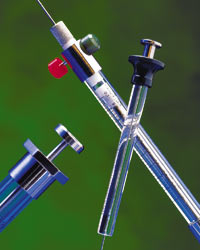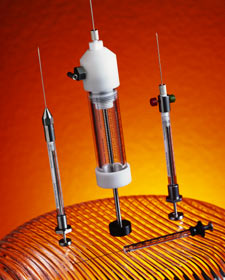Arthur Dent
National Hazard
   
Posts: 553
Registered: 22-10-2010
Member Is Offline
Mood: entropic
|
|
Glass syringes
Okay so this may sound like a dumb question, but how do these things work?
I bought this nice "Genuine Jena Glass" syringe a few days ago. In particular for the potassium experiment where i'll use it as a supplier through a
rubber stopper for the t-butanol since glass is more heat resistant than the plain plastic BD syringes.

It's just a lovely thing all in fine ground glass. I noticed first that the piston was quite loose inside the syringe's body. So I tried it out by
filling it with water and installing a standard needle on it.
The thing squirted as much water behind the piston than what came out at the tip of the needle. 
Do I need to put vacuum grease on that thing so that it works? Won't it contaminate the solution in it? Is there something i'm missing? If I recall
correctly, glass syringes aren't supposed to have a rubber pad at the end of the plunger, do they?
And to my knowledge, glass doesn't shrink? There is not a trace of wear on either component...
Robert
[Edited on 12-2-2011 by Arthur Dent]
--- Art is making something out of nothing and selling it. - Frank Zappa ---
|
|
|
Magic Muzzlet
Hazard to Others
  
Posts: 146
Registered: 22-7-2010
Member Is Offline
Mood: No Mood
|
|
I have a few glass syringes and it sounds like maybe yours just is not made well. Mine have a great seal and are quite snug. Usually the liquid I'm
transferring will wet the area between the plunger and barrel, creating a pretty much perfect seal.
Bt yeah, it really should not leak out the plunger
Also, where did you obtain the syringe?
This is where I got mine from, they are high quality:
http://www.nttworldwide.com/syringe.htm
[Edited on 12-2-2011 by Magic Muzzlet]
|
|
|
Arthur Dent
National Hazard
   
Posts: 553
Registered: 22-10-2010
Member Is Offline
Mood: entropic
|
|
I found the syringe at my favorite lab glassware surplus store in St-Jean, Qc. Paid five bucks for it! They had several others, but this one looked
pretty much unused and very clean so I grabbed it.
But i doubt it's a dud because that glass syringe manufacturer is world renowned, and I checked around the net and one of these thing new is worth
'round $60.
I'm starting to wonder if the piston is not mismatched. Maybe one of the salespersons at the store mixed-up the plunger of one syringe with another...
Hmmm. 
Robert
--- Art is making something out of nothing and selling it. - Frank Zappa ---
|
|
|
entropy51
Gone, but not forgotten
    
Posts: 1612
Registered: 30-5-2009
Member Is Offline
Mood: Fissile
|
|
Quote: Originally posted by Arthur Dent  | I'm starting to wonder if the piston is not mismatched. Maybe one of the salespersons at the store mixed-up the plunger of one syringe with another...
Hmmm.  |
The best syringes were manufactured so that any plunger would fit any barrel with the same capacity.
More often the plunger and barrel had a matching number fired onto the glass so that it was possible to correctly match them up.
A matched set will fit so tightly that you cannot pull the plunger out if the needle connector is sealed.
But in general a random plunger will not tightly fit in a mismatched barrel, even one from the same manufacturer.
|
|
|
peach
Bon Vivant
    
Posts: 1428
Registered: 14-11-2008
Member Is Offline
Mood: No Mood
|
|
I've had one of these and yes, the plungers are loose feeling. With virtually no friction, they can feel strange to use compared to a normal rubber
sealed syringe. If you let go of the plunger mid transfer, it can fall back out.
They're typically used for gas sampling or air-free work.
Have a look at this Wiki article
| Quote: | | This line of syringes is not 100% gas tight since the seal is essentially ground-glass on ground-glass. Fortunately it is possible to remarkedly
improve its sealing ability by applying vacuum grease or an acceptable wetting agent (water,oil) to the ground-glass area. Depending upon your
application or sampling requirements, you may be able to obtain quite satisfactory performance. |
^NTT's site
I have two others that are borosillicate & teflon based (a 10ml and a 1ml). They have a 250psi burst pressure, as the plunger is screwed in at the
back.

The red and green buttons control a valve in the tip so the sample can be locked off from the atmosphere before the blade is drawn out. As these are
often used to puncture rubber seals, they use a none coring blade. The end of the blade has a tiny scoop shape to it, so it cuts a slit and pushes the
rubber out of the way, rather than cutting a core like a normal blade; which would then leave a hole in the seal for atmosphere to get into the
bottles and flasks through.

Unlike a leur lock, these use a pinhole sized opening. The syringe end of the blade pokes into this hole, which is an attempt to minimise the amount
of dead space volume. The plunger and stop of the syringe are flat to effect this also.
These ones are entirely the opposite to the glass on glass. They don't need grease because the teflon is a real tight fit. It actually takes a fair
bit of force to move it, definitely more than a normal surgical syringe.

Here's another example of a moving ground glass seal; an overhead stir gland.
When the contents of a flask become too slushy and thick for magnetic stirring, it needs an overhead stirrer with more torque. And, when the contents
need putting under vacuum or an intert atmosphere, the gland needs to create a seal.
This is done by filling the cup surrounding the gland with oil.
Magnetic stirrers, particularly the oval bars in RBFs, are not at all good once things get a bit thick or lumpy. The bar either sits at the bottom,
spinning with nothing moving around it, or entirely jams.
If you've got something thick or gritty to stir, and don't want to use an overhead stirrer, an Erlenmeyer with a big flat stir bar does a much better
job.

The outer part stays still. The bit I'm holding turns.


These two parts are parallel ground, and the fit is tighter than my first girlfriend. It's close enough that they're not supposed to be put together
without some grease present, as they can bind and jam in place.

[Edited on 12-2-2011 by peach]
|
|
|
Arthur Dent
National Hazard
   
Posts: 553
Registered: 22-10-2010
Member Is Offline
Mood: entropic
|
|
THank you Peach! 
Again you are an endless source of knowledge! I guess i'll try a little bit of vacuum grease midway through the plunger. And next time, i'm at that
glassware shop, i'll pick up one of the syringes with the metallic ends like yours!
Robert
--- Art is making something out of nothing and selling it. - Frank Zappa ---
|
|
|
The WiZard is In
International Hazard
    
Posts: 1617
Registered: 3-4-2010
Member Is Offline
Mood: No Mood
|
|
The metallic fitting are called Luer Lock, though these days
of plastic needle ends the LL is part of the glass body, the
original LL's were metal and used all metallic needles.
http://en.wikipedia.org/wiki/Luer_taper
There do be a SL of Luer Lock fittings ...
http://www.vitaneedle.com/adapters.htm
djh
----
I expect that Women will be the last
thing civilised by Man.
George Meredith
http://www.vitaneedle.com/adapters.htm
[Edited on 13-2-2011 by The WiZard is In]
|
|
|
Fleaker
International Hazard
    
Posts: 1252
Registered: 19-6-2005
Member Is Offline
Mood: nucleophilic
|
|
@Peach,
Do you have a link to the supplier of those syringes you have? I really like them. Looks like they're for proper air-free work.
For what it's worth, most of the time that you find those ground glass syringes very leaky, it's because they were used in a university lab--graduate
students have a habit of base bathing everything. Such was my experience.
[Edited on 13-2-2011 by Fleaker]
Neither flask nor beaker.
"Kid, you don't even know just what you don't know. "
--The Dark Lord Sauron
|
|
|
peach
Bon Vivant
    
Posts: 1428
Registered: 14-11-2008
Member Is Offline
Mood: No Mood
|
|
Here's a link. The ones in my hand are from the Gas / Liquid line, which seem to be the only ones to feature locks on the tips. These are the A2's.
It's also neat because they are in production and the site has spare blades and components up.
They sell them with the intended use being HPLC, but they are of coarse also applicable to air-free work as well.
I expect you can already guess, but they are not cheap. I seem to remember $80+, or it may have even been £80. Air-expensive.
Gas / Liquid line;


[Edited on 13-2-2011 by peach]
|
|
|
hissingnoise
International Hazard
    
Posts: 3940
Registered: 26-12-2002
Member Is Offline
Mood: Pulverulescent!
|
|
Glindemann rings on the plunger might improve things?
|
|
|
peach
Bon Vivant
    
Posts: 1428
Registered: 14-11-2008
Member Is Offline
Mood: No Mood
|
|
I haven't tried the rings on a glass one, but I think they're going to be too thick for the plunger to even get back into the body.
|
|
|
Fleaker
International Hazard
    
Posts: 1252
Registered: 19-6-2005
Member Is Offline
Mood: nucleophilic
|
|
Thanks Peach!
£80 or $80...well worth it if it protects the purity of the reagents and the safety of the chemist. Would you want to handle t-butyl lithium with a
leaky syringe?
Neither flask nor beaker.
"Kid, you don't even know just what you don't know. "
--The Dark Lord Sauron
|
|
|
Arthur Dent
National Hazard
   
Posts: 553
Registered: 22-10-2010
Member Is Offline
Mood: entropic
|
|
UPDATE! 
I went back to the store with my squirty syringe and got confirmation of what entropy51 was mentioning... These glass syringes have a matching number
printed on the plunger and the syringe body. The one I got last week didnt!
So I got a replacement with the same number on both parts of the apparatus and indeed, not a trace of liquid seeps from behind the plunger, and when
pushing the plunger on the empty syringe, you can actually feel the plunger push back because of the gas compression. It's very tight but it slides
fluidly. Very nice!
while I was there, I also bought a few steel body needles for the syringe, and a nifty condenser with both ends 24/40 ground glass joints, now i'm
ready to do some serious distillin' with that baby!
Robert
--- Art is making something out of nothing and selling it. - Frank Zappa ---
|
|
|